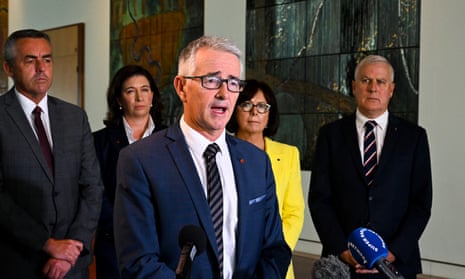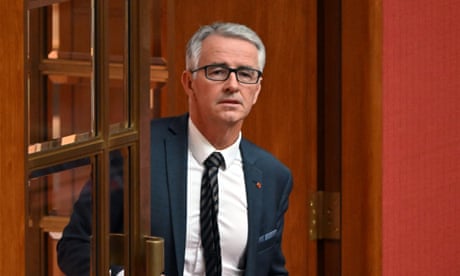Extract from The Guardian

The governing Coalition had left a trail of death and destruction, both figuratively and literally. Thousands of homes were destroyed, dozens of lives lost, 24 million hectares burned, and Australia was shunned from an international climate summit over the then prime minister Scott Morrison’s climate intransigence. Meanwhile, the rightwing Murdoch media machine continued to spew climate disinformation, cynically blaming the devastation on arson and “back-burning”. Things appeared pretty bleak. Yet at the same time, I sensed that something had changed.
There was fiercer-than-usual pushback against the Murdoch disinformation campaign. The media narrative had shifted from questioning to highlighting the role climate change was playing in the unfolding crisis. I had numerous opportunities during my brief sojourn to help the public connect the dots.
But denial was not dead. My media appearances on ABC’s Q&A and 60 Minutes featured tussles with climate-denying politicians, including former Liberal party senator Jim Molan and Nationals MP Barnaby Joyce. A year later I would encounter more of the same. I was testifying remotely at an Australian Senate media diversity inquiry about the role of the Murdoch media in promoting climate denial and delay in Australia. Queensland Liberal party senator Gerard Rennick confronted me with what he purported (without any context or sourcing) to be conflicting data from different climate reports. We were somehow supposed to believe that this “gotcha” invalidated all of climate science. He was reprimanded by the chair for his transparent effort to try to deflect the conversation from the topic at hand.
One year later, Rennick would be widely mocked for insisting to CSIRO head Larry Marshall, as he testified in a Senate committee hearing on economics legislation, that the Heisenberg uncertainty principle of quantum mechanics somehow invalidates global climate models. Having done graduate studies in both theoretical physics and climate science I can assure the reader that this is laughably absurd.
And this is where we intersect the current timeline. This past week I exchanged words once again with Rennick. He had posted a clip of his exchange with Marshall on Twitter, insisting – quite nonsensically – that CO2 cannot warm the atmosphere because of “gravity” and “convection”. As supposed evidence he insisted that “the surface of the Earth is warmer than say the top of Mt Everest” because gravity “traps convection”. I politely explained to him that this is not the case.
I informed him that the cooling of the atmosphere with altitude has nothing to do with “convection” but rather is a consequence of the balance of forces (pressure and gravity) and the conservation of energy (in fact, convection actually tends to the very opposite of what he’s claiming, tending to relieve the gravitational instability of having lighter air beneath heavier air by transporting heat upward, reducing the cooling with altitude). I even provided the lecture notes from my introductory college course on atmospheric science where I derive the relationship, inviting him to point out any errors he could identify.
Rennick chose not to do that. Instead, he insisted I was “making a fool” of myself, disparaged my scientific work and called me “champ”. At this point, I became a bit less charitable in my online engagement with him. Other participants have been similarly uncharitable. Among the links readers have supplied to put his tweet in a more accurate context is a climate explainer for young children from Nasa.
We should view these outbursts of denialism as rearguard skirmishes in what I’ve called “The New Climate War”. Climate denial is now a distraction, a sideshow intended to feed the conservative base with red meat while pacifying polluters. In a post-Black Summer world, where the reality and threat of the climate crisis have been laid bare, the true battle has moved on, from outright denial to deflection, distraction, and most of all, delay.
Thanks in part to delay tactics from the Liberal party, voters rejected them in the federal election of May 2022, and now in every state but Tasmania. In fact, the battle lines on climate have retreated so far now that the real fight isn’t over whether climate change is real or human caused, or even whether we should act. It’s now about what form action should take.
Next month I return to Australia for a speaking tour after a three-year absence, and at a poignant moment indeed.
The climate crisis continues to deepen. In place of the unprecedented bushfires of 2020 we have the floods of 2022 and 2023. In place of scorched koalas in New South Wales we have village-dwelling crocodiles in Queensland. It’s a reminder of the shape-shifting nature of a crisis that promises ever-greater extremes at both ends of the scale. That’s the bad news.
The good news? After nearly a decade, Australia once again has a meaningful climate policy, after ongoing and somewhat heated negotiations between the Albanese government and the Greens. One can quibble over whether it goes far enough. But Greens leader Adam Bandt put it this way: “To everyone who is despairing about the future and wants real climate action, today you should have a spring in your step, because it shows we can take on the coal and gas corporations and win.”
Is that enough? Climate action requires global cooperation. After substantial progress at Cop26 in Glasgow, the Cop27 meeting in Sharm El Sheikh late last year yielded minimal additional progress, failing to secure emissions reductions from the countries of the world that will keep warming of the planet below a catastrophic 1.5C. The recently-released UN IPCC Synthesis Report finds that this target is still within reach but it will require dramatic action in the years ahead.
So we find ourselves in an atmosphere of uncertainty, a bit like the erstwhile-ambivalent Rick Blaine and resistance fighter Victor Laszlo at the end of Casablanca. The fate of the second world war remained unclear, but there was an air of optimism. As Laszlo said to Rick, we say now to Australia: Welcome back to the fight.

No comments:
Post a Comment